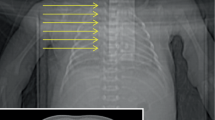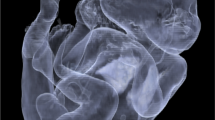Abstract
Proof of live birth is of major importance in suspected neonaticide cases. Although not without controversy the lung flotation test is the main method used to asses this in different jurisdictions worldwide. The present study examines the usefulness of postmortem multislice computed tomography (pmMSCT) in the detection of live birth signs. Body scans were conducted on four infants, one was stillborn, another died a day after birth and the other two were classified as neonaticides. The appearance of the lungs, gastrointestinal tract and vascular system of the liver was compared in these cases. Clear differences were discernable between the lungs of the stillborn and the 1 day old infant. The aerated lungs and air in the stomach and duodenum were clearly visible in the latter case while the stillborn infant lacked these signs. The two neonaticide cases demonstrated similarly aerated lung tissue to the 1 day old infant. The hepatic vessels did not show any putrefactive gas changes in any of the cases. The extent of aeration of the peripheral alveoli was easily observable on the pmMSCT, thus making it a useful tool in the possible differentiation between artificially and naturally aerated lungs. During the four autopsies the classic flotation tests were performed and similar positive aeration of the lungs in the two neonaticides was shown. The stillborn’s tests, on the other hand were negative for aeration. The results of this study clearly demonstrate the advantages of using pmMSCT before commencing a conventional autopsy in cases of suspected neonaticide.












Similar content being viewed by others
References
Kellet RJ. Infanticide and child destruction—the historical, legal and pathological aspects. Forensic Sci Int. 1992;53:1–28.
Hartmann G, Mueller B. Kindestötung. In: Mueller B, editor. Gerichtliche Medizin. Teil 2. Toxikologie, Sexualpathologie, Forensische Gynäkologie, Vaterschaft. Zweite, neubearbeitete und erweiterte Auflage. Berlin: Springer; 1975. pp. 1172–1211.
Byard RW. Medicolegal problems with neonaticide. In: Tsokos M, editor. Forensic pathology reviews, vol. One. Totowa: Humana Press; 2004. p. 171–85.
Byard RW. Neonaticide. In: Payne-James J, Byard RW, Corey TS, Henderson C, editors. Encyclopedia of forensic and legal medicine, vol. Three. Amsterdam: Elsevier Academic Press; 2005. p. 363–70.
Byard RW. Sudden death in the young. 3rd ed. New York: Cambridge University Press; 2010.
Madea B. Praxis rechtsmedizin. 2nd ed. Heidelberg: Springer Medizin Verlag; 2007.
Walcher K. Das Neugeborene in forensischer Hinsicht. Berlin: Springer; 1941.
Büttner CG. Vollständige Anweisung wie durch anzustellende Besichtigungen ein verübter Kindermord auszumitteln sey, nebst Acht und Achtzig beygefügten eigenen Obductions = Zeugnissen, zum Nutzen derer neuangehenden Aerzte und Wundärzte. Königsberg und Leipzig: Joh. Dan. Zeisens Wittwe und Joh. Heinr. Hartungs Erben; 1771.
Hübner EAL. Die Kindestötung in gerichtsärztlicher Beziehung. Erlangen: Ferdinand Enke; 1846.
Reese JJ. Text-book of medical jurisprudence and toxicology. 6th ed. Revised by Leffmann H. Philadelphia: P. Blakiston’s Son & Co; 1902.
Glaister J. A text-book of medical jurisprudence and toxicology. 3rd ed. New York: William Wood and Company; 1915.
Rosset A, Spadola L, Ratib O. OsiriX: an open-source software for navigating in multidimensional DICOM images. J Digit Imaging. 2004;17:205–16.
Saukko P, Knight B. Knight’s forensic pathology. 3rd ed. London: Arnold; 2004.
Thali MJ, Yen K, Schweitzer W, Vock P, Boesch C, Ozdoba C, Schroth G, Ith M, Sonnenschein M, Doernhoefer T, Scheurer E, Plattner T, Dirnhofer R. Virtopsy, a new imaging horizon in forensic pathology: virtual autopsy by post-mortem multislice computed tomography (MSCT) and magnetic resonance imaging (MRI)—a feasibility study. J Forensic Sci. 2003;48:386–403.
Dirnhofer R, Jackowski C, Vock P, Potter K, Thali MJ. VIRTOPSY: minimally invasive, imaging-guided virtual autopsy. Radigraphics. 2006;26:1305–33.
Sakurai T, Michiue T, Ishikawa T, Yoshida C, Sakoda S, Kano T, Oritani S, Maeda H. Postmortem CT investigation of skeletal and dental maturation of the foetuses and newborn infants: a serial case study. Forensic Sci Med Pathol. 2012;. doi:10.1007/s1202401293270.
Brough AL, Rutty GN, Black S, Morgan B. Post-mortem computed tomography and 3D imaging: anthropological applications for juvenile remains. Forensic Sci Med Pathol. 2012;. doi:10.1007/s120240129344z.
Dürwald W. Vorwort. In: Dürwald W, editor. Gerichtliche Medizin im 19. Jahrhundert—Ein gerichtsmedizinischer Pitaval zusammengestellt aus Fachzeitschriften des 19. Jahrhunderts. Band 3. Kindstötung. Leipzig: Reprintverlag Leipzig; 1990. pp. VII–XVII.
Blumenstok H. Zum 200jährigen Jubiläum der Lungenprobe (1883). Reprint. In: Dürwald W, editor. Gerichtliche Medizin im 19. Jahrhundert—Ein gerichtsmedizinischer Pitaval zusammengestellt aus Fachzeitschriften des 19. Jahrhunderts. Band 3. Kindstötung. Leipzig: Reprintverlag Leipzig; 1990. pp. 120–149.
Casper JL. Leben des Neugeborenen ohne Atmen? (1856). Reprint. In: Dürwald W, editor. Gerichtliche Medizin im 19. Jahrhundert—Ein gerichtsmedizinischer Pitaval zusammengestellt aus Fachzeitschriften des 19. Jahrhunderts. Band 3. Kindstötung. Leipzig: Reprintverlag Leipzig; 1990. pp. 167–190.
Franz. Sind Leben und Athmen in gerichtlich-medicinischer Hinsicht identisch? (1856). Reprint. In: Dürwald W, editor. Gerichtliche Medizin im 19. Jahrhundert—Ein gerichtsmedizinischer Pitaval zusammengestellt aus Fachzeitschriften des 19. Jahrhunderts. Band 3. Kindstötung. Leipzig: Reprintverlag Leipzig; 1990. pp. 191–213.
Zeissing. In der Theorie: ohne Athmen Neugeborener dennoch Leben, in der Praxis: ohne Athmen Neugeborener kein Leben (1858). Reprint. In: Dürwald W, editor. Gerichtliche Medizin im 19. Jahrhundert—Ein gerichtsmedizinischer Pitaval zusammengestellt aus Fachzeitschriften des 19. Jahrhunderts. Band 3. Kindstötung. Leipzig: Reprintverlag Leipzig; 1990. pp. 215–245.
Klusemann W. Hydrostatische Lungenprobe und Gebären im Stehen (1857). Reprint. In: Dürwald W, editor. Gerichtliche Medizin im 19. Jahrhundert—Ein gerichtsmedizinischer Pitaval zusammengestellt aus Fachzeitschriften des 19. Jahrhunderts. Band 3. Kindstötung. Leipzig: Reprintverlag Leipzig; 1990. pp. 246–268.
Gheorghe A, Banner J, Hansen SH, Stolborg U, Lynnerup N. Abandonment of newborn infants: a Danish forensic medical survey 1997–2008. Forensic Sci Med Pathol. 2011;7:317–21.
Acknowledgments
Dr. René Gapert’s stay at the Institute of Legal Medicine and Forensic Sciences in Berlin was supported by a DAAD Research Scholarship (German Academic Exchange Service Research Grant A/11/75955). The authors would like to thank the anonymous reviewers for their helpful comments.
Author information
Authors and Affiliations
Corresponding author
Rights and permissions
About this article
Cite this article
Guddat, S.S., Gapert, R., Tsokos, M. et al. Proof of live birth using postmortem multislice computed tomography (pmMSCT) in cases of suspected neonaticide: advantages of diagnostic imaging compared to conventional autopsy. Forensic Sci Med Pathol 9, 3–12 (2013). https://doi.org/10.1007/s12024-012-9361-y
Accepted:
Published:
Issue Date:
DOI: https://doi.org/10.1007/s12024-012-9361-y




